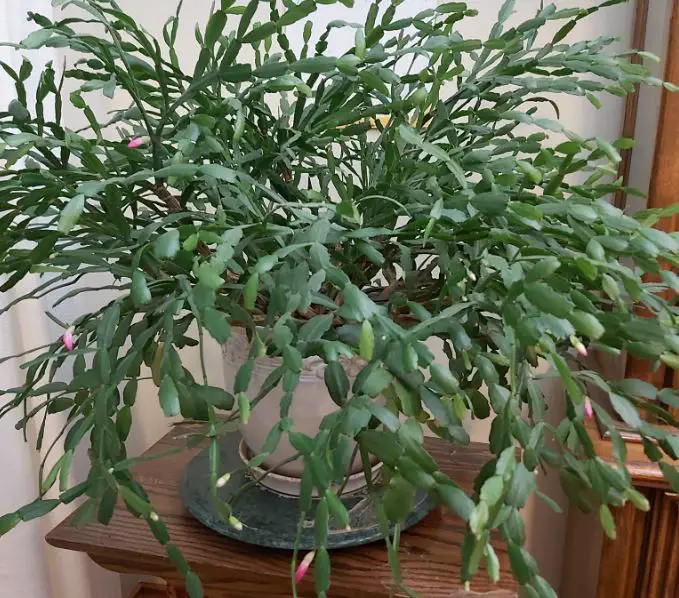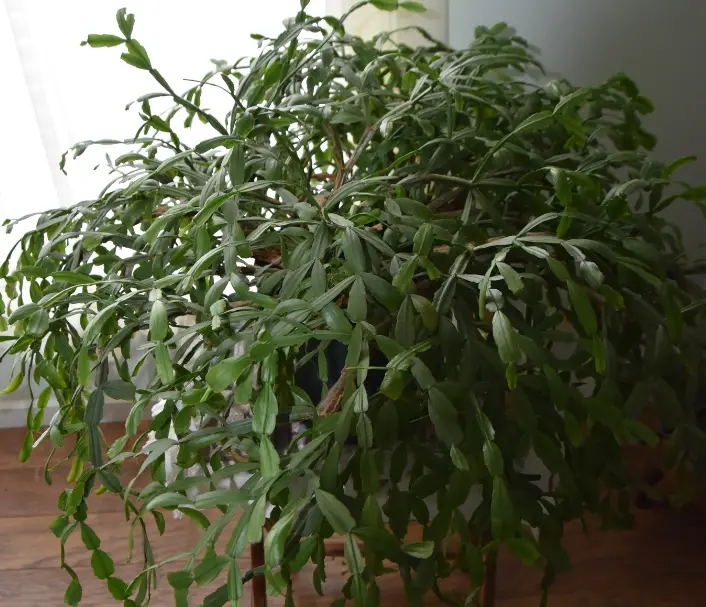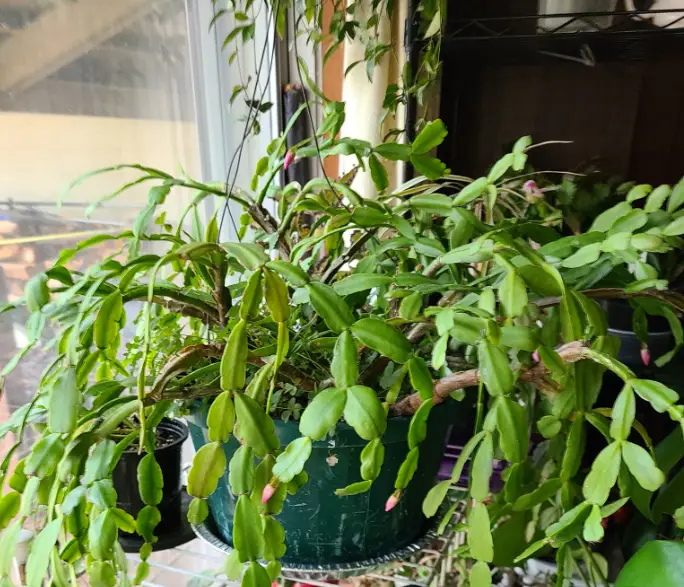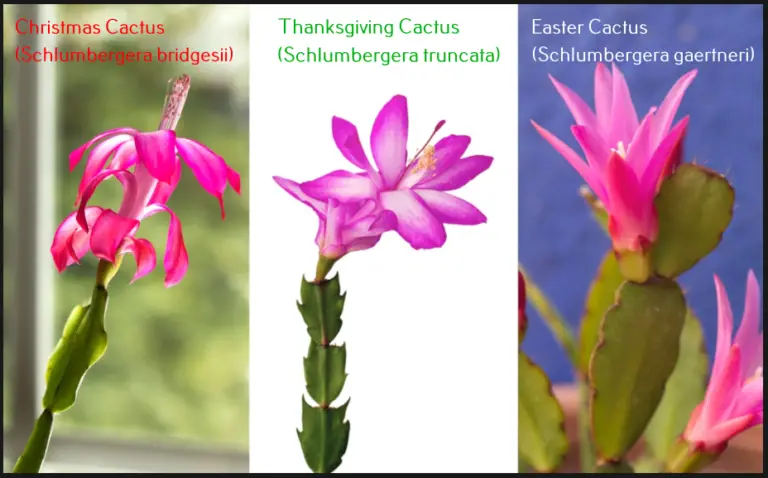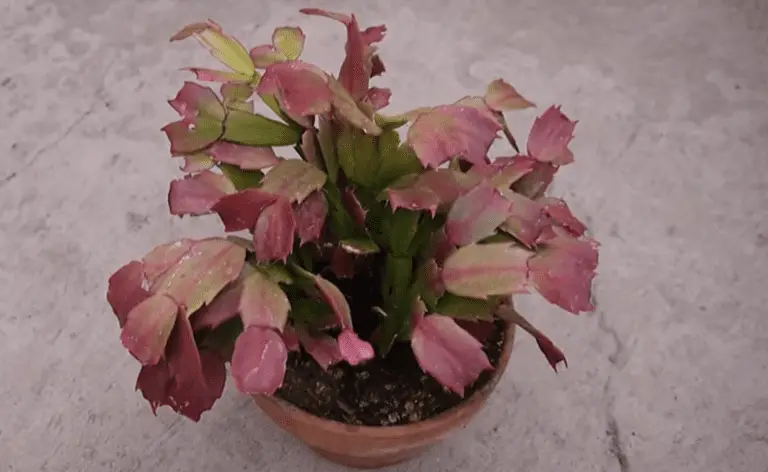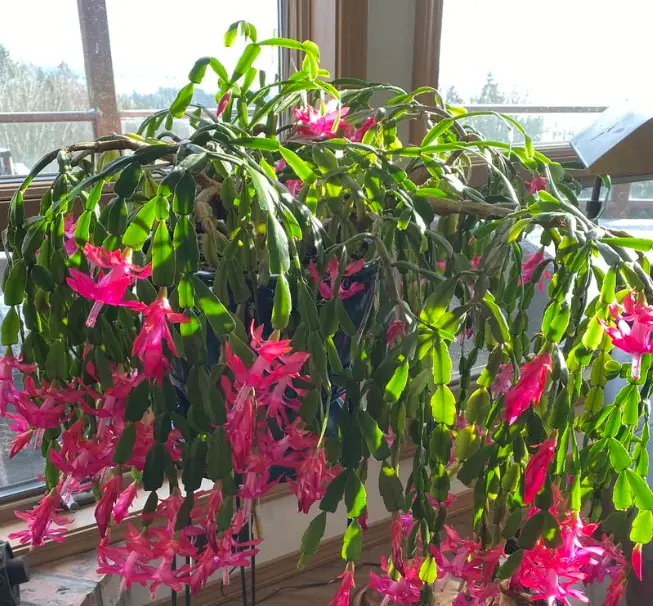Do Christmas Cactus Need Sunlight? (How Much)?
Light, water, air, nutrients, and space to grow are any plant’s basic needs. Most plants need sunlight but can also grow under artificial light. The light is used to make glucose used by plants as their energy source.
Various plants have different light requirements. The Christmas cactus thrives in bright indirect light. When exposed to direct light, the plant will get scorched. Christmas cactus leaves turning red is commonly a distress from severe sunlight.
Too much direct sunlight during blooming will also cause the flowers and buds to wilt and drop. Christmas cacti need light but not necessarily sunlight because they can thrive in artificial light. If the plant is not getting enough light, it may grow thin and spindly and not bloom.
Do Christmas cactus need sunlight?
The Christmas cactus need light to grow, form buds, and flower. However, the light does not have to be sunlight because the right artificial light will serve the same purpose. Indirect light through the window is enough for the plant.
The Christmas cactus will need light for;
Light for photosynthesis
Photosynthesis is the process by which plants (including the Christmas cactus) make their food. During photosynthesis, the Christmas cactus taps light energy through the green pigment known as chlorophyll and transforms it into chemical energy.
The leaves take up light energy and convert water, carbon dioxide, and minerals into oxygen and glucose (energy).
Light during blooming
To get a Christmas cactus to bloom, the plant must be kept in absolute darkness for 12 to 14 hours daily and in bright indirect light for the rest of the day. Without the light episode, the plant will not bloom.
How much light do the Christmas cactus need?
The amount of sunlight a Christmas cactus receives directly affects its size and coloration. A plant’s natural inclination is to seek out the brightest spot possible. If a plant is exposed to direct sunlight for long periods of time, it will begin to lose its green color to red or purple.
Plants that receive indirect sunlight (shade) have a longer lifespan than those that receive direct sunlight. In their native habitat, Christmas cacti receive shielding from directed sunlight by the dense forest cover.
Here are important terms to know about light:
- Indirect light is light that comes from a direction other than straight down. As a result, the light does not travel directly toward the plant. Instead, it travels at an angle and reflects off objects before reaching the plant. This type of light is often referred to as diffused light and is ideal for plants that require less direct sunlight.
- Direct light is a type that shines directly onto a plant. This light is best suited for plants requiring direct sunlight, like the desert cactus. However, these lights are also more intense and cause burn marks on the plant’s surface.
- Shade refers to any area where the plant cannot receive direct sunlight. Trees or buildings may create shade areas. When a plant is placed in the shade, it will still receive some light, but not enough to sustain proper growth.
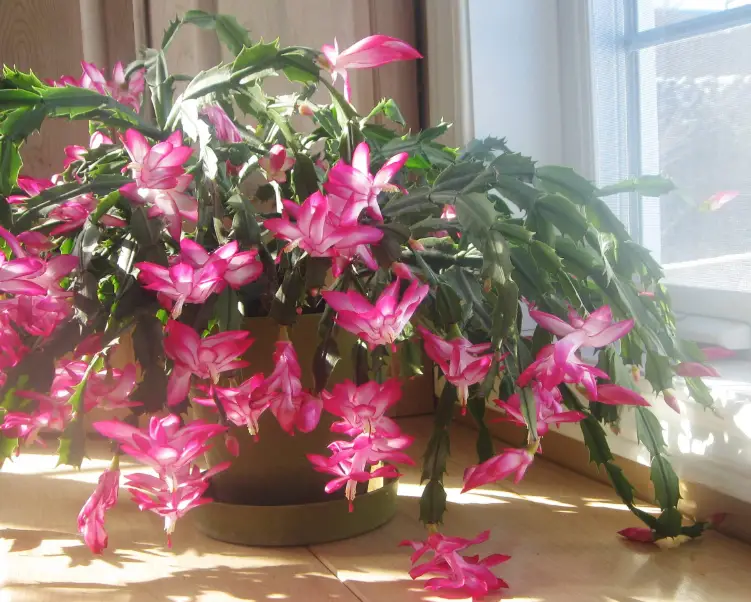
How long should I keep my Christmas cactus indoors?
If you plan on keeping your Christmas cactus indoors over the winter months, you should keep it in a location that receives indirect sunlight. You should also ensure that the temperature inside the room remains between 65-75 degrees Fahrenheit.
Christmas cactus can also be kept indoors as a houseplant, and given good care, it can live more than 20 years without any problem.
The best place to put your Christmas cactus inside the house is near the east or north-facing window and outside under a shade. When kept on a south or west-facing window, diffuse the light with a diffusing device or a semi-transparent curtain.
If your house is dark, you can use grow lights. These lights are designed to provide the specific spectrum of light needed for plants to grow and thrive.
Noe that, you may find your cactus leaning on one side, particularly in the direction where light is coming from if you dont rotate it every other week. Additionally, indoor plants that dont receive enough light may grow spindly, pale and unhealthy.
Can a Christmas cactus live with artificial light?
A Christmas cactus needs light to grow. The light can be either bright indirect light from the sun or artificial. If your house does not get enough natural light or does not want to expose the Christmas cactus to natural light because it might be too bright, you can use artificial light.
The market has various options for artificial light, but not all of them are ideal for Christmas cacti. The Christmas cactus requires cool temperatures, and a light that produces a lot of heat might not be ideal.
Also, you need to understand the light spectrum on how different light will affect the plant. Below are some artificial lights available in the market that are ideal for the Christmas cactus.
1. Fluorescent light
Fluorescent light comes either in the traditional long tube or the modern compact fluorescent light bulb (CFL), lasting 10,000 hours. The fluorescent bulb is cool and emits lots of blue light wavelength.
Since they lack red hues, you can purchase the whitest fluorescent bulb because it has all spectrum colors.
2. Incandescent bulbs
Incandescent bulbs are warm and emit the red wavelength important for flowering. They produce a lot of heat and should be kept at least one foot away from the Christmas cactus. However, they lack the blue hues important for healthy leaves. The bulb can last for 1000 hours.
3. Metal halide
Metal halide light emits white-colored light and is ideal for Christmas cactus because they are good for the full growth from the vegetative flowering to the fruiting stage.
4. High-pressure sodium
High-pressure sodium lights are high-intensity lights that emit yellow and red wavelengths. They are ideal for budding and flowering. It is long-lasting and very energy efficient.
5. LED grow light
Not all LED lights are designed for plant growth. However, the LED grow light is the best option in the market. It is very energy efficient, has an ultra-low heat output, and has a good light spectrum.
Should artificial light be left on throughout?
Darkness is very crucial in the growth of plants. During the day, light helps the Christmas cactus produce energy through photosynthesis, and at night the plant breaks down the energy for growth and flowering through respiration.
During the plant’s growth stage, giving it at least eight to ten hours of darkness is important. However, you must increase the dark hours from twelve to sixteen to encourage the Christmas cactus to bloom.
Therefore you cannot leave the artificial light on throughout.
When positioning the light bulb, ensure to keep it at a safe distance from the plant because an increased temperature due to lighting will result in cactus buds falling off and wilting of flowers.
Sunlight vs. artificial light for cactus
Sunlight is natural and free and gives the plant exactly what they need. Light has several wavelengths, and each produces a different color. Sunlight is rich in red and blue wavelengths, essential for plant growth.
The blue part of the spectrum helps the healthy growth of the leaves, and the red promotes flowering and fruiting.
On the other hand, most artificial lights produce more yellow and green wavelengths, while others produce red or blue wavelengths but not both. Growing your Christmas cactus with bright indirect sunlight is ideal, but even artificial light will do.
When using artificial light, it is essential to understand the parts of the light spectrum and the purpose each serves.
Recap
The Christmas cactus need bright indirect sunlight to grow, and flower but can still thrive in artificial light. However, not all lights are ideal for house plants because some produce much heat while others do not emit the right light wavelength.
Even when using artificial lighting, it is important to allow the Christmas cactus to sit in the dark by switching off the light.
References:
- Michigan State University: The secret to getting a Christmas cactus to bloom
- N.C. Cooperative Extension: Christmas Cactus Care
- Purdue University: Getting Christmas Cactus to Re-bloom
My name is Diane M Lewik, and I am the founder of this website. I am a degree holder in plant biology from the University of California – Berkeley. Over the years, I have cultivated a vast collection of succulents and I have learned a great deal about how to grow and care for these unique plants. Feel free to ask any questions in the comment section below.
